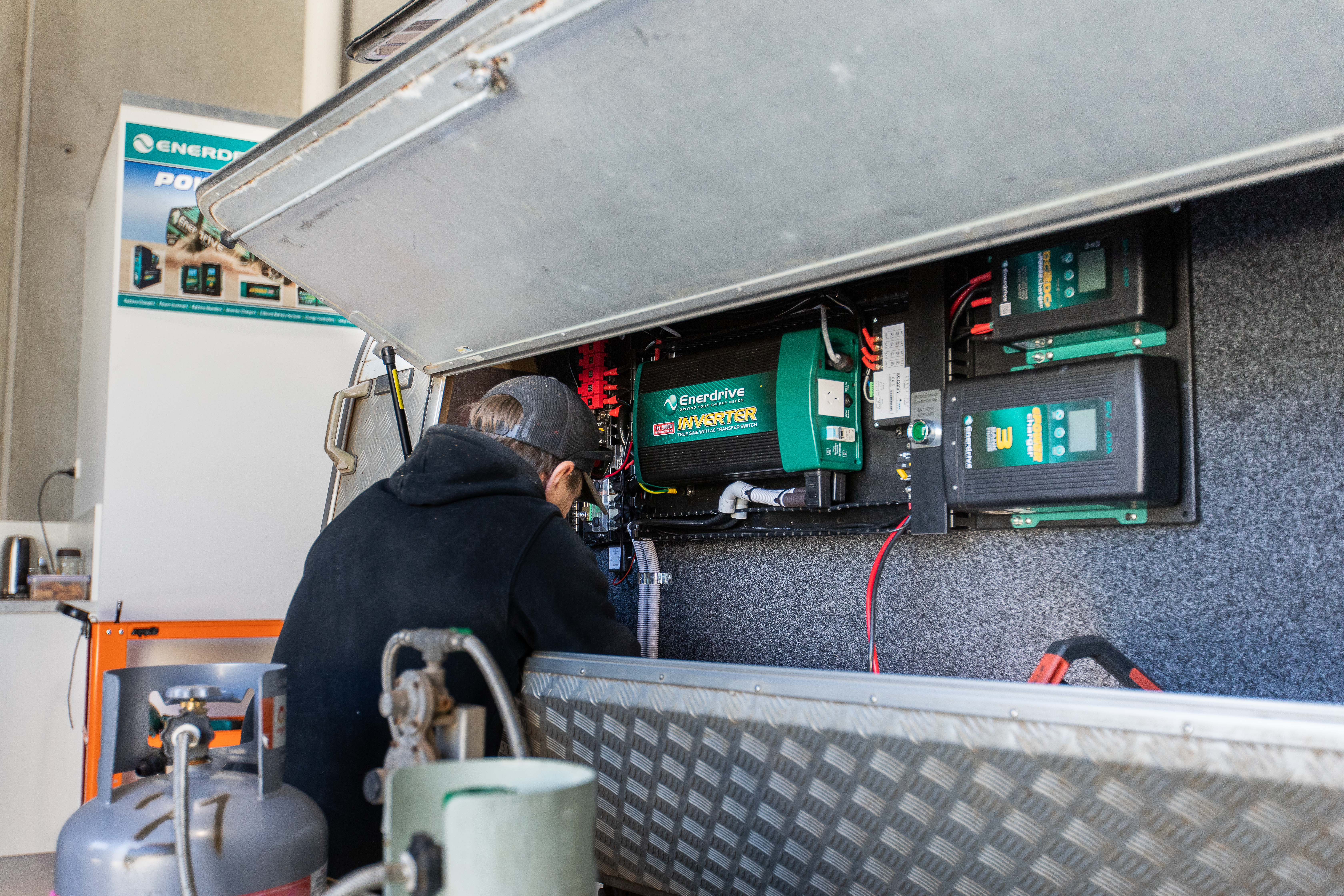As the caravan industry gears up for a transformative shift, all eyes are on the impending arrival of brand-new standards that take effect November 2023. Titled AS/NZS3001.2:2022, these changes promise to revolutionise the way we approach portable connectable electrical installations, particularly in the realm of lithium battery standards. The standard is a detailed document and covers electrical installations in RVs as well as other connectable installation used for accommodation, habitation or commercial.
This blog will highlight a few of the changes around battery standards, specifically focusing on portable connectable electrical installations (Caravans, Motorhomes and Camper Trailers).
What is a portable connectable electrical installation? Put simply, any vehicle that has a 240V inlet plug fitted on the outside for mains power connection. These plugs are usually 15 Amp and connect to a battery management system within the van. At time of writing, vehicles without the hard wired 240V inlet are exempt from the latest standards changes.
While these changes may seem significant, they are indeed achievable and not overly complex. Let's delve into what these upcoming regulations mean for every caravan enthusiast.
Existing Power Installations:
Before we get into it, it’s worth mentioning that if you already have a caravan with lithium batteries or inverters installed, and it was delivered before these new standards come into effect, there's no need to worry. The new caravan industry standards are not retrospectively enforceable. Only if you're upgrading your existing system from, say, AGM batteries to lithium, should you carefully consider the standard requirements.
Battery Fitment Standards:
Perhaps the most critical aspect of the new caravan industry standards is battery fitment. Contrary to some misconceptions, you don't need to mount your batteries outside the caravan. They can be safely installed internally in non-habitable areas such as storage locations, tunnel boots, and under beds. It's essential to follow the battery manufacturer's guide for proper installation, securing, and ventilation.
If you already have a power system installed before November 18, 2023, but want to make sure your system is still complying to the new rules one simple step is segregating the lithium batteries from the rest of the system with a wall and a secured lid as well as a gasket seal to ensure the portion of the build is gas proof. This compartment can be made from any materials as long as it is sealed and secure. Another step is a single ventilation point, 20mm to the external of the caravan.
Solar Compliance:
For parallel connections of 3 or more solar panels, compliance with the new caravan industry standard also requires individual fusing for each panel before they are connected. This additional layer of safety ensures that a short circuit in one panel won't disrupt the entire system. Another new addition to the rules is the need for a fuse, circuit breaker, or a single point of isolation prior to the controller on the solar side. This isolation point is required regardless of the number of panels in the system and allows you to troubleshoot or test any issues you may be having with your panels or something else in the system.
In conclusion, the new lithium battery laws in the caravan industry represent a positive step towards enhanced safety and compliance. If you have any questions or concerns, simply reach out to your battery manufacturer, or don't hesitate to reach out to us and we can point you in the right direction. Always consult your installing electrician for clarity on the latest standards for your installation in your state.
-
DISCLAIMER* Please note, this advice is general in nature and we strongly recommend consulting the product manual and where relevant, a professional installer.
Comments (24)
New battery system installation
Hi, I would like to know if there is any regulations regarding installing a new lithium battery system and 3000w inverter inside tool box on A frame at the front of the caravan next to the gas bottles which are mount externally.By: Darryl Barker on 30 March 2025
www.caravanrvcamping.com.au Response
When installing anything in a caravan near gas, it is always best practice to consult a certified gas fitter in your state. This enables you to meet the standards within your state for safe travelling. Batteries should always be installed at least 300mm from any fuel or water source/lines.
Flexible solar panel upgrade
Hi, I am looking to put 3 x 400w flexible panels on my caravan, connect them in series and feed to a victron mppt 100x50 controller. From reading your article it seems that I don't need to have any fuses, just an isolator before the controller. Is this correct?By: Robert on 22 February 2025
www.caravanrvcamping.com.au Response
Hi Robert, yes the single fusing is for parallel connections. Please also you check your Open Circuit Voltage (VOC) of the panels. Connecting in series increases voltage so checking you are within the specs of the controller is important.
Solar Fuseing
Hi I recently purchased some MC4 fuse connectors. When I inspected them they were ONLY Diodes. The retailer When I questioned the seller they said the diodes were also a fuse due to their power rateing. I have doubts re this logic! Please comment.By: Lauri Watson on 19 January 2025
www.caravanrvcamping.com.au Response
HI Lauri, MC4 Diodes prevent reverse current flow, while fuses protect against overcurrent. They can't be used interchangeably as they serve different purposes.
Solar Fusing
If placing 10 panels upon the roof of a caravan, are we running 10 cables down, fused at the panel and then to a fuse box then an isolator, similar to the video above? Or can we use the MC4 fuse solar connectors, then cables into a string and down to the isolator so only 2 cables coming through the roof? Which is the compliant way? We are reading it as the second version of my comment.By: Indy on 13 November 2024
www.caravanrvcamping.com.au Response
Hi Indy, there needs to be individual fusing per panel, prior to the panels being connected in parallel






